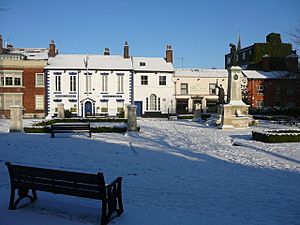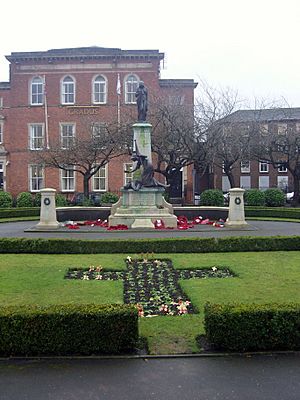Macclesfield Cenotaph facts for kids
The Macclesfield Cenotaph is a special monument in Macclesfield, England. It was built to remember the brave soldiers from the area who lost their lives in World War I. This memorial was officially revealed in 1921. It has a tall stone pillar and three bronze statues. One statue shows a woman who is sad, like someone mourning. The other two statues show Britannia, a symbol of Britain, placing a wreath on a soldier who died from gas. This was quite unusual for a war memorial at the time. The cenotaph is considered a very important historical building, called a Grade II* listed building.
Remembering World War I Heroes
After World War I ended in 1918, people in Macclesfield wanted to create a special place to remember those who had died. In 1919, a public meeting was held, and a committee was formed. This committee asked people to donate money to help build a memorial.
Even though it took some time to collect enough money, the committee asked an artist named John Millard to design the memorial. His design included a statue of Britannia placing a laurel wreath on a soldier who had died from gas. Some people thought this part of the design was too sad or "gruesome." They wanted something more heroic. However, Millard's design was eventually accepted. The memorial was built by local craftsmen, E. and H. Frith. It was officially unveiled by the Mayor of Macclesfield on September 21, 1921. About 20,000 people came to the ceremony.
What the Memorial Looks Like
The Macclesfield Cenotaph is made of stone and bronze. It stands about 7.3 meters (about 24 feet) tall. It has a stone base and a tall pillar. On top of the main pillar is a bronze statue of a woman. She looks sad and holds a wreath, representing the people who stayed home and mourned their loved ones.
At the bottom of the pillar are two more bronze statues. One shows a soldier who has died from gas. He is holding a gas mask that he didn't have time to put on. The other statue is Britannia, who is leaning over the soldier and placing a laurel wreath on his head.
The front of the memorial's base has a message carved into it:
- THIS MEMORIAL WAS ERECTED IN
- HONOUR OF MACCLESFIELD MEN WHO
- GAVE THEIR LIVES FOR THEIR KING
- & EMPIRE IN THE GREAT WAR 1914–1918
- UNVEILED BY THE MAYOR OF MACCLESFIELD
- ALDERMAN J. G. FROST J.P. SEPTEMBER 21ST 1921
Other sides of the pillar list some of the places where the soldiers fought, like France, Belgium, Italy, and Egypt. The names of all the soldiers who died are carved onto bronze plates around the memorial.
Why This Memorial is Special
Most war memorials built after World War I showed heroic scenes or peaceful thoughts. They usually avoided showing the sad or terrible parts of war. It was very unusual to show dead soldiers because people thought it was too upsetting. For example, a similar statue of a dead soldier in London also caused some debate.
However, the Macclesfield Cenotaph is different because it shows the harsh reality of war. This makes it a very interesting and important piece of art. Experts who study public sculptures think it's "of great interest" because it's an exception to the usual designs of the time.
The monument is officially recognized as a Grade II* listed building. This means it's a very important historical building with special interest. It was first listed in 1977 and its importance was upgraded in 2016. People who write about the architecture of Macclesfield have even called it "The finest thing in town."



